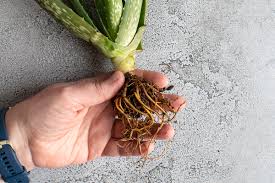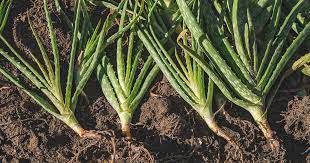Aloe vera roots are an essential component of the aloe vera plant (Aloe barbadensis miller). These roots play a crucial role in anchoring the plant to the soil and absorbing water and nutrients necessary for its growth and survival. Aloe vera roots are typically thin, fibrous structures that extend from the base of the plant into the soil. They may appear pale to dark brown in color and have a somewhat woody texture.
The primary functions of aloe vera roots include providing stability to the plant by anchoring it in the soil and absorbing water and minerals from the surrounding environment. These absorbed nutrients are transported to other parts of the plant for growth and development.
Aloe vera roots consist of several smaller rootlets that branch out and spread in various directions. This branching structure allows the plant to effectively explore the soil for water and nutrients. Aloe vera is well-adapted to arid and semi-arid environments, and its roots reflect this adaptation. They are capable of efficiently absorbing water from the soil, even in challenging conditions with limited moisture.
The growth rate and extent of aloe vera roots depend on various factors, including soil type, moisture availability, and overall plant health. Healthy, well-established aloe vera plants typically have a well-developed root system that supports their above-ground growth.
Aloe vera plants can be propagated from both root cuttings and offsets (pups) that emerge from the base of the mature plant. Root cuttings can be used to start new plants, but the primary method of propagation is through offsets, which already have a small root system.
While the primary focus of aloe vera is often on its gel-filled leaves, some traditional and alternative medicine practices also use aloe vera root extracts for their potential medicinal properties. However, it’s important to note that the majority of aloe vera’s therapeutic benefits are attributed to the gel found in its leaves.
When growing aloe vera as a houseplant or in a garden, it’s important to provide well-draining soil to prevent root rot. Aloe vera prefers soil that allows excess water to drain away quickly. Overwatering can lead to root damage and other health issues for the plant.
The Economic Importance and Uses of Aloe Vera Roots

While the economic importance of Aloe vera roots is limited, they do have some potential uses. Economic Importance of Aloe Vera Roots:
1. Traditional Medicine: In some traditional medicine systems, Aloe vera roots have been used for various health conditions, including digestive issues, constipation, and arthritis. However, scientific evidence supporting these uses is limited.
2. Propagation: Aloe vera plants can be propagated from offsets, stem cuttings, or seeds. While root cuttings are not commonly used for propagation, they might be explored as an alternative method.
3. Soil Stabilization: Aloe vera plants, including their roots, can help stabilize soil in arid and semi-arid regions due to their ability to prevent soil erosion. This can be of economic importance in areas prone to desertification.
Read Also: Aloe Vera Rhizomes: Economic Importance, Uses and By-Products
4. Research and Development: Research into the chemical composition of Aloe vera roots may lead to the discovery of new bioactive compounds with potential pharmaceutical or industrial applications. However, as of my last update, research in this area is limited.
5. Cosmetics and Skincare: While the roots themselves may not be directly used, research into Aloe vera root extracts could lead to the development of new cosmetic or skincare products. Aloe vera is already widely used in cosmetics due to its moisturizing and soothing properties.
6. Alternative Medicine: While Aloe vera leaves and gel are more commonly used in alternative medicine, some traditional practices attribute medicinal properties to the roots as well. These potential uses could include treatments for conditions such as diabetes, inflammation, and immune system support. However, scientific validation is needed to confirm these claims.
7. Herbal Products: Aloe vera roots might be explored as an ingredient in herbal teas, tinctures, or other natural health products. These products could target specific health concerns or offer general wellness benefits.
8. Agricultural Inputs: Extracts from Aloe vera roots might contain compounds that benefit plant growth and development. These extracts could potentially be used as natural growth stimulants or soil conditioners, contributing to sustainable and organic farming practices.
9. Biofuel Production: Aloe vera is known to produce a large amount of biomass, including its roots. Research into the use of Aloe vera roots for biofuel production or as a source of biomass for renewable energy could have economic and environmental implications.
10. Waste Utilization: Aloe vera roots, if not used for other purposes, could potentially be used in waste management systems. For example, they might be composted to enrich soil or used as animal feed.
11. Biodiversity Conservation: Aloe vera is a unique plant species with a range of genetic diversity. Conserving different varieties of Aloe vera, including their roots, can contribute to preserving biodiversity, which has ecological and potential economic value.
12. Cultural and Artistic Uses: Aloe vera roots could have cultural or artistic applications, such as being used in crafts, traditional artworks, or local rituals. These creative uses might have cultural and tourism-related economic benefits.
13. Research and Education: Aloe vera roots could serve as a subject of study for researchers and educators, contributing to botanical, ecological, or ethnobotanical research. This could enhance our understanding of plant biology and traditional knowledge.
The Products and By-products That Can Be Derived From Aloe Vera Roots

Aloe vera is a succulent plant known for its numerous medicinal and cosmetic benefits. However, it’s important to note that most of the beneficial compounds are found in the gel of the leaves, not the roots. While aloe vera roots do contain some bioactive compounds, they are not as commonly utilized as other parts of the plant. That being said, here are some potential products and by-products that can be derived from aloe vera roots:
1. Aloe Vera Root Extract: Aloe vera root extract can be obtained by processing and extracting the bioactive compounds from the roots. However, the concentration of these compounds is generally lower in the roots compared to the leaves.
2. Aloe Vera Root Powder: Dried and powdered aloe vera roots can be used in various applications, including dietary supplements, herbal remedies, or skincare products.
3. Aloe Vera Root Tea: Aloe vera root can be used to make herbal teas, although this is less common than using the leaves. The tea may have potential health benefits, similar to other herbal teas.
4. Aloe Vera Root Gel: Aloe vera root gel can be processed from the roots and used in skincare products or topical applications, although this is less common compared to using gel from the leaves.
5. Aloe Vera Root Extract Oil: Aloe vera root extract can be infused into carrier oils to create aloe vera root extract oil. This oil may have potential uses in aromatherapy or skincare.
Read Also: Types and Benefits of Hydroponic Farming
